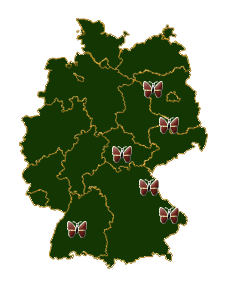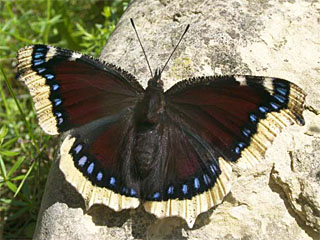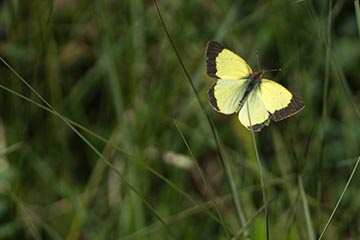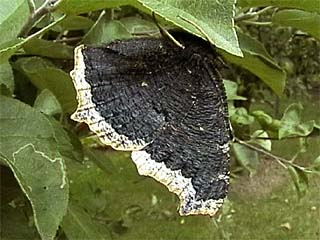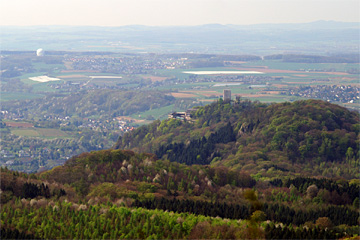Although the  Camberwell BeautyNymphalis antiopa (Linnaeus, 1758)Mourning CloakCamberwell Beauty can be found in all German federal states, there are now only very few areas
Camberwell BeautyNymphalis antiopa (Linnaeus, 1758)Mourning CloakCamberwell Beauty can be found in all German federal states, there are now only very few areas  Germany
Germany Germanys where the butterfly is native.
Germanys where the butterfly is native.
The  Camberwell BeautyNymphalis antiopa (Linnaeus, 1758)Mourning CloakCamberwell Beauty is not common in
Camberwell BeautyNymphalis antiopa (Linnaeus, 1758)Mourning CloakCamberwell Beauty is not common in  Germany
Germany Germany in any location.
Germany in any location.
In many areas where the butterfly was once ubiquitous, it has almost completely disappeared for decades. This also includes near-natural areas that still exist today.
The  Camberwell BeautyNymphalis antiopa (Linnaeus, 1758)Mourning CloakCamberwell Beauty occurs regularly and with constant populations in
Camberwell BeautyNymphalis antiopa (Linnaeus, 1758)Mourning CloakCamberwell Beauty occurs regularly and with constant populations in  Germany
Germany Germany only in Montains (Alps: 800-1850m altitude, Low mountain range 450-1500m altitude)montane areas Weidemann, 1986 - Naturführer Tagfalter Band 1 - Entwicklung-Lebensweise and in parts of eastern
Germany only in Montains (Alps: 800-1850m altitude, Low mountain range 450-1500m altitude)montane areas Weidemann, 1986 - Naturführer Tagfalter Band 1 - Entwicklung-Lebensweise and in parts of eastern  Germany
Germany Germany. These are in particular:
Germany. These are in particular:
 Camberwell BeautyNymphalis antiopa (Linnaeus, 1758)Mourning CloakCamberwell Beauty
Camberwell BeautyNymphalis antiopa (Linnaeus, 1758)Mourning CloakCamberwell Beauty
Camberwell Beauty (Nymphalis antiopa)
- Black Forest, Baden-Württemberg,
 GermanyBlack Forest
GermanyBlack Forest - Bavarian Forest, Bavaria,
 GermanyBavarian Forest
GermanyBavarian Forest - Cool regions of the Upper Palatinate, Bavaria,
 GermanyUpper Palatinate
GermanyUpper Palatinate - At the foot of the Thuringian Forest, Bavaria,
 GermanyThuringian Forest
GermanyThuringian Forest - In parts of Brandenburg,
 GermanyBrandenburg, in and around Berlin,
GermanyBrandenburg, in and around Berlin,  GermanyBerlin1
GermanyBerlin1 - In parts of Saxony Anhalt,
 GermanySaxony Anhalt and Saxony,
GermanySaxony Anhalt and Saxony,  GermanySaxony
GermanySaxony
There are several attempts to explain what exactly is causing the sharp decline of  Camberwell BeautyNymphalis antiopa (Linnaeus, 1758)Mourning CloakCamberwell Beauty's in
Camberwell BeautyNymphalis antiopa (Linnaeus, 1758)Mourning CloakCamberwell Beauty's in
- Natural cyclical population fluctuations, e.g. due to climatic influences, predators or parasites Ebert; Rennwald, 1991 - Die Schmetterlinge Baden-Württembergs. Band 1, Tagfalter I Young, 1980 - Some observations on the natural history and behavior of the Camberwell Beauty (Mourning Cloak) butterfly, Nymphalis antiopa (Linnaeus) (Lepidoptera; Nymphalidae) in the United States.
- Global climate change, e.g. due to warmer winters and/or rainier summers Kinkler, 1997 - War die Hoffnung auf die Wiederansiedlung des Trauermantels Nymphalis antiopa (LINNAEUS, 1758) im Rheinland trügerisch? (Lep., Nymphalidae).
- Increased use of insecticides, which pollutes the important food source fallen fruit Weidemann, 1988 - Naturführer Tagfalter Band 2 - Biologie-Ökologie-Biotopschutz.
- Destruction of larval habitats, e.g. by straightening and clearing forest edges, whereby willows and birches in particular are removed Settele, 1999 - Die Tagfalter Deutschlands.
- Clearing up forest areas with the associated removal of hibernation sites, such as wood piles or brushwood heaps Settele, 1999 - Die Tagfalter Deutschlands.
- An epidemic in which populations can be completely wiped out by disease Busch, 1970 - Tag- und Nachtfalter in der Hocheifel.
Some populations in  Germany
Germany Germany have been able to recover through immigration from more easterly areas. A collapse of the populations in northern BavariaBavaria in the post-war years was followed, for example, by recolonisation from the border strip to today's
Germany have been able to recover through immigration from more easterly areas. A collapse of the populations in northern BavariaBavaria in the post-war years was followed, for example, by recolonisation from the border strip to today's  Czechia
Czechia Czechia from around 1960 Weidemann, 1988 - Naturführer Tagfalter Band 2 - Biologie-Ökologie-Biotopschutz.
Czechia from around 1960 Weidemann, 1988 - Naturführer Tagfalter Band 2 - Biologie-Ökologie-Biotopschutz.
Although the butterfly sometimes undertakes enormous migrations, it has hardly spread further in  Germany
Germany Germany in recent decades (in contrast to other migratory butterflies, only some of the butterflies leave their place of origin).
Germany in recent decades (in contrast to other migratory butterflies, only some of the butterflies leave their place of origin).
In Schleswig-HolsteinSchleswig-Holstein, the  Camberwell BeautyNymphalis antiopa (Linnaeus, 1758)Mourning CloakCamberwell Beauty is not considered native Kolligs, 2003 - Schmetterlinge Schleswig-Holsteins, Atlas der Tagfalter, Dickkopffalter und Widderchen.
Camberwell BeautyNymphalis antiopa (Linnaeus, 1758)Mourning CloakCamberwell Beauty is not considered native Kolligs, 2003 - Schmetterlinge Schleswig-Holsteins, Atlas der Tagfalter, Dickkopffalter und Widderchen.
1The Camberwell Beauty (Nymphalis antiopa) is often seen in the south/south-east of Berlin in particular (source: André Mattuschka, pers. comm.).
The  Camberwell BeautyNymphalis antiopa (Linnaeus, 1758)Mourning CloakCamberwell Beauty disappeared completely in the northern Rhineland and western Westphalia after the cold winter of 1954/55 and has not naturalised again since then Kinkler, 1996 - Wiedereinwanderung des Trauermantels Nymphalis antiopa (LINNAEUS, 1758) ins nördliche Rheinland und ins westliche Westfalen (Lep., Nymphalidae).
Camberwell BeautyNymphalis antiopa (Linnaeus, 1758)Mourning CloakCamberwell Beauty disappeared completely in the northern Rhineland and western Westphalia after the cold winter of 1954/55 and has not naturalised again since then Kinkler, 1996 - Wiedereinwanderung des Trauermantels Nymphalis antiopa (LINNAEUS, 1758) ins nördliche Rheinland und ins westliche Westfalen (Lep., Nymphalidae).
This unusually harsh winter was also responsible for the extinction of the entire population of  Moorland Clouded YellowColias palaeno (Linnaeus, 1761)Palaeno sulphurPale Arctic Clouded YellowMoorland Clouded Yellow in the High Fens,
Moorland Clouded YellowColias palaeno (Linnaeus, 1761)Palaeno sulphurPale Arctic Clouded YellowMoorland Clouded Yellow in the High Fens,  BelgiumHigh Fens.
BelgiumHigh Fens.
Das Hohe Venn
 Moorland Clouded YellowColias palaeno (Linnaeus, 1761)Palaeno sulphurPale Arctic Clouded YellowMoorland Clouded Yellow
Moorland Clouded YellowColias palaeno (Linnaeus, 1761)Palaeno sulphurPale Arctic Clouded YellowMoorland Clouded Yellow
A flying male Moorland Clouded Yellow (Colias palaeno) in the Hinterzarten moor
It was around 30° degrees in the Hinterzarten moor that day. I saw around a dozen Moorland Clouded Yellows (Colias palaeno) fluttering through the moor. Again and again they sat down on the flowers of the Purple marshlocks (Potentilla palustris) to take nectar.
Due to the lack of protective snow, all of the butterfly's overwintering caterpillars fell victim to the icy temperatures LÖBF, 1997 - Praxishandbuch Schmetterlingsschutz.
The  Moorland Clouded YellowColias palaeno (Linnaeus, 1761)Palaeno sulphurPale Arctic Clouded YellowMoorland Clouded Yellow has since died out in the High Fens,
Moorland Clouded YellowColias palaeno (Linnaeus, 1761)Palaeno sulphurPale Arctic Clouded YellowMoorland Clouded Yellow has since died out in the High Fens,  BelgiumHigh Fens.
BelgiumHigh Fens.
Occasional sightings of the  Camberwell BeautyNymphalis antiopa (Linnaeus, 1758)Mourning CloakCamberwell Beauty's in the Rhineland and Westphalia are probably due to bred specimens or isolated immigrants. Permanent or established populations are unlikely.
Camberwell BeautyNymphalis antiopa (Linnaeus, 1758)Mourning CloakCamberwell Beauty's in the Rhineland and Westphalia are probably due to bred specimens or isolated immigrants. Permanent or established populations are unlikely.
Noteworthy is the year 1995, in which an unusually large number of butterflies were reported, there was even talk of re-immigration Kinkler, 1996 - Wiedereinwanderung des Trauermantels Nymphalis antiopa (LINNAEUS, 1758) ins nördliche Rheinland und ins westliche Westfalen (Lep., Nymphalidae). Compared to the number of reports in the  Kingdom of the Netherlands
Kingdom of the Netherlands Kingdom of the Netherlands (approx. 1000 butterflies) and
Kingdom of the Netherlands (approx. 1000 butterflies) and  Denmark
Denmark Denmark (approx. 2000 butterflies), where there were mass migrations in 1995, the Rhineland/Westphalia reports were rather modest.
Denmark (approx. 2000 butterflies), where there were mass migrations in 1995, the Rhineland/Westphalia reports were rather modest.
Just one year later, it became apparent that the number of butterflies was too low and the weather conditions too unfavourable for successful reintroduction.
Even in the  Kingdom of the Netherlands
Kingdom of the Netherlands Kingdom of the Netherlands there was a rapid decline in reports in the following period, with only 25 butterflies being sighted there in spring 1997 Kinkler, 1997 - War die Hoffnung auf die Wiederansiedlung des Trauermantels Nymphalis antiopa (LINNAEUS, 1758) im Rheinland trügerisch? (Lep., Nymphalidae).
Kingdom of the Netherlands there was a rapid decline in reports in the following period, with only 25 butterflies being sighted there in spring 1997 Kinkler, 1997 - War die Hoffnung auf die Wiederansiedlung des Trauermantels Nymphalis antiopa (LINNAEUS, 1758) im Rheinland trügerisch? (Lep., Nymphalidae).
In the district of Ahrweiler (approx. 20 km south-west of Bonn,  GermanyBonn), the
GermanyBonn), the  Camberwell BeautyNymphalis antiopa (Linnaeus, 1758)Mourning CloakCamberwell Beauty occurred in large numbers between 1924 and 1940 Busch, 1970 - Tag- und Nachtfalter in der Hocheifel:
Camberwell BeautyNymphalis antiopa (Linnaeus, 1758)Mourning CloakCamberwell Beauty occurred in large numbers between 1924 and 1940 Busch, 1970 - Tag- und Nachtfalter in der Hocheifel:
... on birches and willows in all valleys ... as long as the food plant was there, the large caterpillar communities ... hung on the forage branch. At that time, thousands of  Camberwell BeautyNymphalis antiopa (Linnaeus, 1758)Mourning CloakCamberwell Beauty-caterpillars could easily have been brought in and reared as butterfly.
Camberwell BeautyNymphalis antiopa (Linnaeus, 1758)Mourning CloakCamberwell Beauty-caterpillars could easily have been brought in and reared as butterfly.
Not a single butterfly was seen there in 1970.
 Camberwell BeautyNymphalis antiopa (Linnaeus, 1758)Mourning CloakCamberwell Beauty
Camberwell BeautyNymphalis antiopa (Linnaeus, 1758)Mourning CloakCamberwell Beauty
Camberwell Beauty (Nymphalis antiopa) hanging under a leaf
[Breeding image]
Breeding: Gerd LintzmeyerGerd Lintzmeyer
The  Camberwell BeautyNymphalis antiopa (Linnaeus, 1758)Mourning CloakCamberwell Beauty is not native or indigenous to Bonn,
Camberwell BeautyNymphalis antiopa (Linnaeus, 1758)Mourning CloakCamberwell Beauty is not native or indigenous to Bonn,  GermanyBonn.
GermanyBonn.
 Camberwell BeautyNymphalis antiopa (Linnaeus, 1758)Mourning CloakCamberwell Beauty in Bonn,
Camberwell BeautyNymphalis antiopa (Linnaeus, 1758)Mourning CloakCamberwell Beauty in Bonn,  GermanyBonn and the surrounding area only once alive and once again as a dead butterfly in over 50 years. See Encounters (1977) and Encounters (2021).
GermanyBonn and the surrounding area only once alive and once again as a dead butterfly in over 50 years. See Encounters (1977) and Encounters (2021). Large TortoiseshellNymphalis polychloros (Linnaeus, 1758)Large Tortoiseshell
Large TortoiseshellNymphalis polychloros (Linnaeus, 1758)Large Tortoiseshell
Large Tortoiseshell (Nymphalis polychloros) in the Kottenforst
I was very surprised when I saw a Large Tortoiseshell (Nymphalis polychloros) for the first time in Bonn in spring 2014. Two specimens were doing their rounds at the foot of a willow tree and repeatedly sat down to sunbathe on the gravel path or the dried vegetation of the previous year. The Large Tortoiseshell (Nymphalis polychloros) is the closest relative of the Camberwell Beauty (Nymphalis antiopa).
The closest relative of the  Camberwell BeautyNymphalis antiopa (Linnaeus, 1758)Mourning CloakCamberwell Beauty's, the
Camberwell BeautyNymphalis antiopa (Linnaeus, 1758)Mourning CloakCamberwell Beauty's, the  Large TortoiseshellNymphalis polychloros (Linnaeus, 1758)Large Tortoiseshell, on the other hand, has been found in Bonn since the mid-2010s.
Large TortoiseshellNymphalis polychloros (Linnaeus, 1758)Large Tortoiseshell, on the other hand, has been found in Bonn since the mid-2010s.
The  Large TortoiseshellNymphalis polychloros (Linnaeus, 1758)Large Tortoiseshell was named Butterfly of the Year 2018 by the Bund für Umwelt und Naturschutz Deutschland e.V. (BUND) NRW Nature Conservation Foundation and the Arbeitsgemeinschaft Rheinisch-Westfälischer Lepidopterologen.
Large TortoiseshellNymphalis polychloros (Linnaeus, 1758)Large Tortoiseshell was named Butterfly of the Year 2018 by the Bund für Umwelt und Naturschutz Deutschland e.V. (BUND) NRW Nature Conservation Foundation and the Arbeitsgemeinschaft Rheinisch-Westfälischer Lepidopterologen.
The only other known sightings of the  Camberwell BeautyNymphalis antiopa (Linnaeus, 1758)Mourning CloakCamberwell Beauty in the last decades in and around Bonn,
Camberwell BeautyNymphalis antiopa (Linnaeus, 1758)Mourning CloakCamberwell Beauty in the last decades in and around Bonn,  GermanyBonn are listed in articles by Helmut KinklerHelmut Kinkler Kinkler, 1996 - Wiedereinwanderung des Trauermantels Nymphalis antiopa (LINNAEUS, 1758) ins nördliche Rheinland und ins westliche Westfalen (Lep., Nymphalidae) Kinkler, 1997 - War die Hoffnung auf die Wiederansiedlung des Trauermantels Nymphalis antiopa (LINNAEUS, 1758) im Rheinland trügerisch? (Lep., Nymphalidae):
GermanyBonn are listed in articles by Helmut KinklerHelmut Kinkler Kinkler, 1996 - Wiedereinwanderung des Trauermantels Nymphalis antiopa (LINNAEUS, 1758) ins nördliche Rheinland und ins westliche Westfalen (Lep., Nymphalidae) Kinkler, 1997 - War die Hoffnung auf die Wiederansiedlung des Trauermantels Nymphalis antiopa (LINNAEUS, 1758) im Rheinland trügerisch? (Lep., Nymphalidae):
| Location | Date | Number of butterflies |
|---|---|---|
Bonn,  GermanyBonn-Kottenforst, North Rhine-Westphalia, GermanyBonn-Kottenforst, North Rhine-Westphalia,  GermanyKottenforst GermanyKottenforst |
14/04/1996 | 1 |
| Königswinter-Oberdollendorf | 12/09/1995 | 1 |
| Wachtberg-Pech | 17/08/1995 | 1 |
The Drachenfels seen from the Oelberg
Around 150 years ago, the  Camberwell BeautyNymphalis antiopa (Linnaeus, 1758)Mourning CloakCamberwell Beauty must have still existed in the area around Bonn,
Camberwell BeautyNymphalis antiopa (Linnaeus, 1758)Mourning CloakCamberwell Beauty must have still existed in the area around Bonn,  GermanyBonn: Henry Gardiner Adams (1811-1881)Henry Gardiner Adams quoted an unknown author in 1854, who discovered some
GermanyBonn: Henry Gardiner Adams (1811-1881)Henry Gardiner Adams quoted an unknown author in 1854, who discovered some  Camberwell BeautyNymphalis antiopa (Linnaeus, 1758)Mourning CloakCamberwell Beauties (see Stories/Poems (Henry Gardiner Adams: Beautiful Butterflies: Camberwell Beauty (1854))) Adams, 1854 - Beautiful Butterflies: The British Species described and illustrated with an introductory chapter containing the History of a Butterfly through all its changes and transformations on the summit of the Drachenfels, North Rhine-Westphalia,
Camberwell BeautyNymphalis antiopa (Linnaeus, 1758)Mourning CloakCamberwell Beauties (see Stories/Poems (Henry Gardiner Adams: Beautiful Butterflies: Camberwell Beauty (1854))) Adams, 1854 - Beautiful Butterflies: The British Species described and illustrated with an introductory chapter containing the History of a Butterfly through all its changes and transformations on the summit of the Drachenfels, North Rhine-Westphalia,  GermanyDrachenfels in the Siebengebirge, North Rhine-Westphalia,
GermanyDrachenfels in the Siebengebirge, North Rhine-Westphalia,  GermanySiebengebirge near Bonn,
GermanySiebengebirge near Bonn,  GermanyBonn.
GermanyBonn.




